mobile Ansicht, to the English Version tap the flag


- Staat Israel
- parlamentarische Republik innerhalb von Grenzen,
die dem UNO-Beschluss von 1947 und den UNO-Resolutionen 181 und 242 widersprechen
- Eigenbezeichnung: Medinat Jisrael
• Flaggen
• historische Flaggen
• Bedeutung/Ursprung der Flagge
• Wappen
• Bedeutung/Ursprung des Wappens
• Flugzeugkokarde
• Landkarte
• Zahlen und Fakten
• Geschichte
• Ursprung des Landesnamens
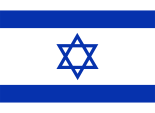
Nationalflagge,
Seitenverhältnis = 8:11,
Quelle, nach: Flaggen und Wappen, Corel Draw 4






Handelsflagge,
Seitenverhältnis = 29:45,
Quelle, nach: Flaggen und Wappen, Corel Draw 4




Marineflagge,
Seitenverhältnis = 29:45,
Quelle, nach: Flaggen und Wappen, Corel Draw 4



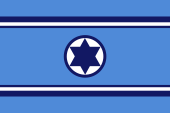
Flagge der Luftwaffe,
Seitenverhältnis = 2:3,
Quelle, nach: Flags of the World, Wikipedia (EN)




Standarte des Präsidenten an Land,
Seitenverhältnis – ratio = 1:1,
Quelle, nach:
Flaggen und Wappen



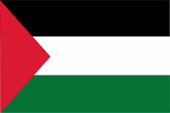
Flagge der autonomen palästinensischen Gebiete,
Seitenverhältnis – ratio = 2:3,
Info? hier klicken: Palästina






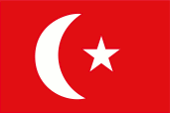
bis 1916,
Flagge Osmanisches Reich,
Quelle, nach:
Wikipedia (EN)




1916–1927,
Flagge Großbritanniens,
Seitenverhältnis = 1:2,
Quelle, nach:
Flags of the World





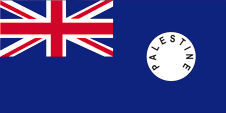
1927–1948
Flagge der Regierung (Staatsflagge),
Seitenverhältnis = 1:2,
Quelle, nach:
Flags of the World



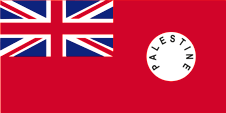
1927–1948
Handelsflagge,
Seitenverhältnis = 1:2,
Quelle, nach:
Flags of the World




Die Flagge Israels ist weiß mit einem blauem Davidstern in der Mitte, und zeigt oben und unten je einen blauen Streifen. Die Breite der dadurch entstehenden weißen und blauen Streifen verhält sich wie 14:30:85:30:14. Sie wurde von dem zionistischen Führer David Wolfsohn entworfen und erstmals am 21.07.1891 bei der Einweihung der Zion-Halle in Boston (USA) in der Öffentlichkeit gezeigt. Am 14.05.1948 wurde sie erstmals in Palästina gehisst, und am 12.09.1948 offiziell als Flagge des jüdischen Staates bestätigt. Der Davidstern ist ein jüdisches Symbol. Er entsteht durch das Kombinieren von zwei gleichschenkligen Dreiecken. Blau und Weiß sind Farben jüdischer Ritualkleidung und die Flagge geht laut David Wolfsohn auf den jüdischen Gebetsschal (Talit) zurück. Oft wird jedoch folgendes unterstellt: Da die Flagge von einem Zionisten geschaffen wurde, sei es wahrscheinlicher, dass kein äußeres Zeichen jüdischer Religion wiedergegeben wurde, sondern eine auf das Land Israel selbst bezogene Aussage dargestellt ist. So sei die Flagge als eine Interpretation des Kapitels 15 Vers 18 des 1. Buches Mose (Genesis 15:18) zu sehen, in der die Lage des von Abraham den Juden versprochenen Landes zwischen Nil und Euphrat versinnbildlicht wird: An dem Tage schloss der Herr einen Bund mit Abraham und sprach: "Deinen Nachkommen will ich dieses Land geben, von dem Strom Ägyptens bis an den großen Strom Euphrat." Es liegen keine Angaben oder Quelle vor, die den Farbton Blau exakt definieren. Das betrifft alle drei Farbtöne, das Mittelblau der Nationalflagge, das Marineblau der Seeflaggen und das Hellblau der Flagge der Luftwaffe. Für die Nationalflagge lässt sich Pantone 300 finden, Pantone 281 und Pantone 286. Das Blau in den Seeflaggen wird Marineblau genannt, gemäß der Farbtafel des Flaggenkatalogs der Britischen Streitkräfte "Flags of all Nations" wäre Marineblau als Pantone 282 zu definieren, das Hellblau der Luftwaffe als Azurblau Pantone 549.
Quelle:
Die Welt der Flaggen,
Flaggen Wappen Hymnen,
Flaggen und Wappen der Welt,
Wikipedia (DE),
Wikipedia (EN),
Flags of the World,
Flags of all Nations


Wappen von Israel,
Quelle, nach:
Flaggen und Wappen

Das Staatswappen wurde am 11.02.1949 offiziell eingeführt. Es zeigt die Menorah, den siebenarmigen Leuchter des alten Jerusalemer Tempels, und wird links und rechts von zwei Olivenzweigen eingefasst. Darunter in hebräischer Schrift der Name des Landes.
Quelle:
Flaggen Wappen Hymnen


Flugzeugkokarde,
Quelle, nach: Wikipedia (EN)

Lage:
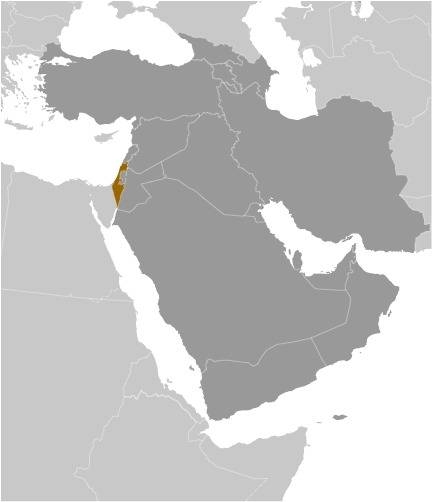
Quelle/Source: CIA World Factbook
Landkarte des Landes:
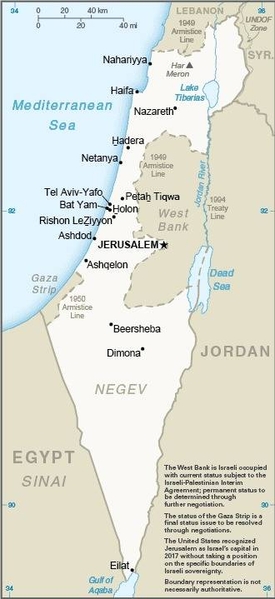
Quelle/Source: CIA World Factbook

Fläche nach UN-Beschluss 1947: 14.000 km²
Fläche, ohne besetzte Gebiete: 22.380 km²
Fläche, mit besetzten Gebieten: 29.211 km²
Einwohner: 9.136.000 (2019), davon 74% Juden, 21% Araber
Religionen (2009): 35% Nicht-Religiöse, 24% traditionelle Juden, 17% Moslems, 11% orthodoxe Juden, 5% ultraorthodoxe Juden, 2% Christen, 2% Drusen
Bevölkerungsdichte: 313 Ew./km²
Hauptstadt: Jerusalem (Al Kuds), –international wenig anerkannt– 919.438 Ew. (2018)
Amtssprachen: Iwrith (Neuhebräisch), Arabisch
sonstige Sprachen: Russisch, Deutsch, Jiddisch, Englisch
Währung: 1 Neuer Israel Schekel (ILS, NIS) = 100 Agorot
Zeitzone: MEZ + 1 h
Quelle:
Wikipedia (DE)

Geschichte bis 1862, siehe → Palästina
1862 · Herausbildung des Zionismus als jüdische Nationalbewegung
1917 · Balfour-Deklaration – Großbritannien beansprucht große Teile des Osmanischen Reiches nach dem bevorstehenden Kriegsende, und erklärt sich mit der Bildung einer „nationalen Heimstätte“ für die Juden in diesem Gebiet einverstanden
1920 · der Vertrag von San Remo spricht Großbritannien Palästina, Transjordanien und Irak als Mandatsgebiete des Völkerbundes zu
1922 · Palästina (einschließlich Jordanien) wird britisches Völkerbundsmandat
1923 · Jordanien wird als Emirat Transjordanien abgetrennt
1929 · blutige Auseinandersetzungen zwischen Arabern und Juden
1936 · nach jahrelanger starker jüdischer Einwanderung und keinerlei Reaktion der britischen Mandatsmacht, und keinerlei Garantien für Unabhängigkeit eines arabischen Palästina kommt es zu einem Arabischen Nationalaufstand
1939 · Niederschlagung des letzten arabischen Widerstands, britische Zusage auf einen gemeinsamen jüdisch-arabischen Staat binnen 10 Jahren
1942 · Zionisten fordern in New York die Bildung eines jüdischen Staats in Palästina
29.11.1947 · VN-Beschluss über die Bildung eines jüdischen Staates (Israel) und eines arabischen Staates (Palästina) auf dem Territorium des Mandatsgebietes Palästina → Ablehnung durch die Araber → Bürgerkrieg
14.05.1948 · das britische Mandat für Palästina endet, Proklamierung des Staates Israel
1948–1949 · israelisch-arabischer Krieg, Annexion von 6.700 km² arabischen Territoriums durch Israel, Vertreibung der dort ansässigen arabischen Bevölkerung, die Palästinenser verzichten auf die Proklamation eines arabischen Staates, da er die Anerkennung der Teilung des Landes und der israelischen Annexionen bedeutet hätte
11.05.1949 · Israel wird Mitglied der VN
1950 · "Rückkehrgesetz", alle Juden die sich in Israel ansiedeln erhalten sofort die Staatsbürgerschaft, 1,7 Millionen Juden kommen ins Land
24.04.1950 · Transjordanien übernimmt die Verwaltung des Westjordanlands und nennt sich jetzt Jordanien, Ägypten übernimmt die Verwaltung des Ghazastreifens
29.10.1956 · israelische Aggression gegen Ägypten, Besetzung der Halbinsel Sinai und des Ghazastreifens → Intervention der USA, der Sowjetunion und der VN
25.12.1956 · die israelischen Truppen müssen den Sinai räumen, Stationierung von VN-Tuppen
08.03.1957 · die israelischen Truppen müssen den Ghazastreifen räumen, Stationierung von VN-Tuppen
1967 · Abzug der VN-Truppen
05.06.1967 · Israel greift Ägypten, Syrien und Jordanien an und besetzt innerhalb von sechs Tagen ("Sechstagekrieg") die ganze Sinaihalbinsel, den Gazastreifen, das Westjordanland, Ostjerusalem und die syrischen Golanhöhen
1969–1970 · Kampfhandlungen mit Ägypten am Suezkanal
06.10.1973 · Ägypten und Syrien greifen Israel zur Rückgewinnung der besetzten Gebiete erfolglos an (Jom-Kippur-Krieg)
1974 · Israelisch-Ägyptisches Friedensabkommen
1974 · israelisch-syrisches Abkommen, Teilrückzug der israelischen Truppen von den Golanhöhen
1975 · Israelisch-Ägyptisches Friedensabkommen, Teilrückzug der israelischen Truppen von der Sinaihalbinsel
1978 · Israelisch-Ägyptisches Friedensabkommen von Camp David
26.03.1979 · Israelisch-Ägyptischer Friedensvertrag
1982 · Abzug der letzten israelischen Truppen von der Sinaihalbinsel
06.06.1982 · gegen palästinensische Truppen (PLO) gerichteter Angriff Israels auf Libanon, die PLO muss Libanon verlassen
1985 · Teilrückzug der israelischen Truppen aus dem Libanon, ein breiter Grenzstreifen bleibt besetzt
1988 · Jordanien trennt sich vom Westjordanland
13.09.1993 · Abkommen zwischen Israel und der PLO, Abzug der israelischen Truppen aus dem Gazastreifen und Jericho, Herstellung einer begrenzten lokalen palästinensischen Selbstverwaltung
1994 · Israelisch-Jordanischer Friedensvertrag, Errichtung erster palästinensischer Selbstverwaltungen in Jericho und im Gazastreifen
1995 · Teilrückzug der israelischen Truppen aus dem Westjordanland, palästinensische Selbstverwaltungen in weiteren Städten
1996 · Wahl des palästinensischen Autonomierates mit einem Präsidenten an der Spitze
2001 · Rückzug der israelischen Truppen dem südlibanesischen Grenzstreifen
August 2006 · Israelische Truppen marschieren im Libanon ein, in 34 Tagen Krieg gelingt es nicht die Hisbolla-Miliz zu schwächen, der Süden Libanon wird druch die Aktionen der Israelis weitgehend zerstört
2007 · Kämpfe zwischen den Palästinenser-Fraktionen Hamas und Fatah, die Hamas erobert den gesamten Ghazastreifen und beansprucht die Führung Palästinas
2008–2009 · israelische Militäroperation im Gazastreifen
2014 · israelische Militäroperation im Gazastreifen
07.10.2023 · die Hamas überfällt aus dem Ghazastreifen heraus das umliegende israelische Gebiet und überzieht die Region mit religiös aufgeladenem Terror, binnen zwei Tagen erkämpft Israel die Kontrolle über seine Gebiete zurück und bekämpft in den folgenden Wochen Strukturen der Hamas im Ghazastreifen
Quelle:
Atlas zur Geschichte,
Wikipedia (D),
Weltgeschichte,
Discovery '97

Der Name "Israel" wird erstmals um 1210 v. Chr. auf der Israelstele des Pharaos Merenptah erwähnt. Das bezog sich damals auf die Stämme der Hebräer die in Kanaan lebten. Für den Namen Israel hat man sich 1948 bei der Gründung des Staates entschieden. Andere Vorschläge waren: Zion, Judäa, Neu-Judäa.
Quelle:
Wikipedia (D)


![]()
































